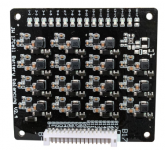robaroni
New Member
- Joined
- Sep 30, 2019
- Messages
- 35
If you're buying BMS controllers from China and are disappointed as to why claims of higher currents fall short this should help give you some perspective.
The problem lies in thin wires supplied, you can't have an AWG 22 wire controlling high currents (over a few hundred mA). It's not that the wire won't carry the current it's that the voltage drop is throwing off the readings the uC (microcontroller) or the comparator sees.
Here's what happens, let's say you want to charge a LiFeP04 battery to 3.65V and shunt the battery when it reaches that voltage with 1.5 amps. Let's also say the sense wire which becomes the shunt wire is 22 AWG. 22 AWG has a resistance of ~142 ohms per 1,000 feet or 0.142 ohms per foot. Now lets say the wires running to the batteries is 18" (1.5 feet) each battery wire. That means that by ohms law Voltage=current x resistance (E=IR) the voltage drop when the battery is shunting is E = 1.5 x (1.5 x 0.142) = 0.32V. This is the voltage drop across the wires. So when the battery is in shunt mode the comparator or uC sees less.
The comparator that is trying to shunt the battery at 3.65 volts now sees 3.65V - 0.32 = 3.33 volts. Comparator circuits have an aspect called "hysteresis". Let's say you want to turn on a shunt to stop charging at 3.65V. If you turn on the shunt at 3.65V you can't turn it off at 3.65V too, you would would get high frequency oscillations because the circuit would work against itself turning off and on simultaneously. Enter hysteresis - what you do is turn on the circuit at one voltage and off at another lower voltage, this difference is called hysteresis. So, say, when the battery drops to 3.60 volts the shunt turns off - except our circuit has dropped to 3.3V due to the loss in the 22 AWG wire China supplied. What you have to do is fudge the circuit, you can change things to compensate but it really doesn't work well. This is why you see higher quality high current circuits directly across the battery. They avoid this mess.
These are the types of BMS controllers you want.
Rob
The problem lies in thin wires supplied, you can't have an AWG 22 wire controlling high currents (over a few hundred mA). It's not that the wire won't carry the current it's that the voltage drop is throwing off the readings the uC (microcontroller) or the comparator sees.
Here's what happens, let's say you want to charge a LiFeP04 battery to 3.65V and shunt the battery when it reaches that voltage with 1.5 amps. Let's also say the sense wire which becomes the shunt wire is 22 AWG. 22 AWG has a resistance of ~142 ohms per 1,000 feet or 0.142 ohms per foot. Now lets say the wires running to the batteries is 18" (1.5 feet) each battery wire. That means that by ohms law Voltage=current x resistance (E=IR) the voltage drop when the battery is shunting is E = 1.5 x (1.5 x 0.142) = 0.32V. This is the voltage drop across the wires. So when the battery is in shunt mode the comparator or uC sees less.
The comparator that is trying to shunt the battery at 3.65 volts now sees 3.65V - 0.32 = 3.33 volts. Comparator circuits have an aspect called "hysteresis". Let's say you want to turn on a shunt to stop charging at 3.65V. If you turn on the shunt at 3.65V you can't turn it off at 3.65V too, you would would get high frequency oscillations because the circuit would work against itself turning off and on simultaneously. Enter hysteresis - what you do is turn on the circuit at one voltage and off at another lower voltage, this difference is called hysteresis. So, say, when the battery drops to 3.60 volts the shunt turns off - except our circuit has dropped to 3.3V due to the loss in the 22 AWG wire China supplied. What you have to do is fudge the circuit, you can change things to compensate but it really doesn't work well. This is why you see higher quality high current circuits directly across the battery. They avoid this mess.
These are the types of BMS controllers you want.
Rob









